
The world of the occult is part of the fun. It’s like a nightmarish amusement park. Nothing is as it seems. Floors can move. Mirrors can talk. We’ll see how to create some of the most popular types of occult environments and how to illuminate them with moody light and shadows in order to generate the most suspense.
If you’re going to draw characters who dwell in the land of darkness, you’ve got to add, well, darkness! Shadows are sinister because they can eerily wrap themselves around a character, almost as if they are sentient beings themselves. They can assume the shape of an object or cast that shape onto another surface. Shadows can stretch or disappear completely. They are mysterious, hiding the things we fear from plain sight. They also create a tense, thick atmosphere, which heightens the suspense of any scene.
It’s sort of counterintuitive, but to draw shadows, you have to think about where you want to place the light. Shadows are what result when light hits an area. If there’s no light, there’s no shadow. So, start to think of the direction of the light hitting your character or your scene. The light may come from one direction or angle, two directions, and sometimes even three directions. But, it’s not everywhere, all the time—not even on a hot summer day outside. Light always comes from a direction. And, where it doesn’t hit is where the shadows appear.
You’ve got to start thinking about it in this logical way. If you don’t—if you shade areas randomly, based simply on what looks good to you—you’ll end up with shadows in places where light hits and light in places where shadows should be, and the image will end up “checkerboarded” with pockets of light and shadow. It looks better when it looks right. Here’s how it should work.
OVERHEAD LIGHT SOURCE: NORMAL LIGHTING/NEUTRAL MOOD
Indoor overhead lighting is the most common type. It falls on the hair, shoulders, arms, hips, and sides of the clothes—but not on everything. What it doesn’t fall on remains in shadow.

LIGHTING FROM BELOW: MENACING MOOD
When you light a character from below, you get a decidedly different mood. It’s spooky, no? This is one of the times that a light source doesn’t have to represent anything occurring in reality. In other words, you don’t have to show the character standing over a fireplace or make sure that another character is holding a lamp below him to justify the low-light effect. We light him from below for purely emotional reasons—because it heightens the drama.

The parts of the figure that protrude—the chest, collar, and face—are hit with the light. The parts that recede—the neck, shoulders, back of the hair, and forehead—are all bathed in shadow (because the light doesn’t hit them).
When you light a character from behind, a rim of light (edge light) falls on the outline of the figure. It’s a very cool look. The contrast of having a large, dark figure outlined in bright light makes the character both mysterious and impossible to ignore.

Even though the eyes of a backlit character should, technically, be in shadow like the rest of the figure, you still add eye shines to them. The shine is what gives the eye life.
Although the shadows should fall in a logical way, you don’t always need a reason for introducing them into a scene. It’s reason enough that shadows enhance mood; they make the characters bold, the moment emphatic. And, they also do another thing: They make the figure appear three-dimensional instead of being left empty—and flat—with only black lines on white paper. The characters tend to take on a feeling of roundness, solidity, weight, and emotional depth.
However, there are some trade-offs, and you have to weigh the pros and cons. Black and white can be stark, intense, and powerful. Some characters, scenes, and even entire graphic novels are better suited to the explosive high-contrast style of black and white—with no shadows or gray. Even then, you can use pools of black as your shadows, thereby applying what you’ve learned here. So experiment. And allow the subject matter to dictate your choice of using grays or blacks for shadows.


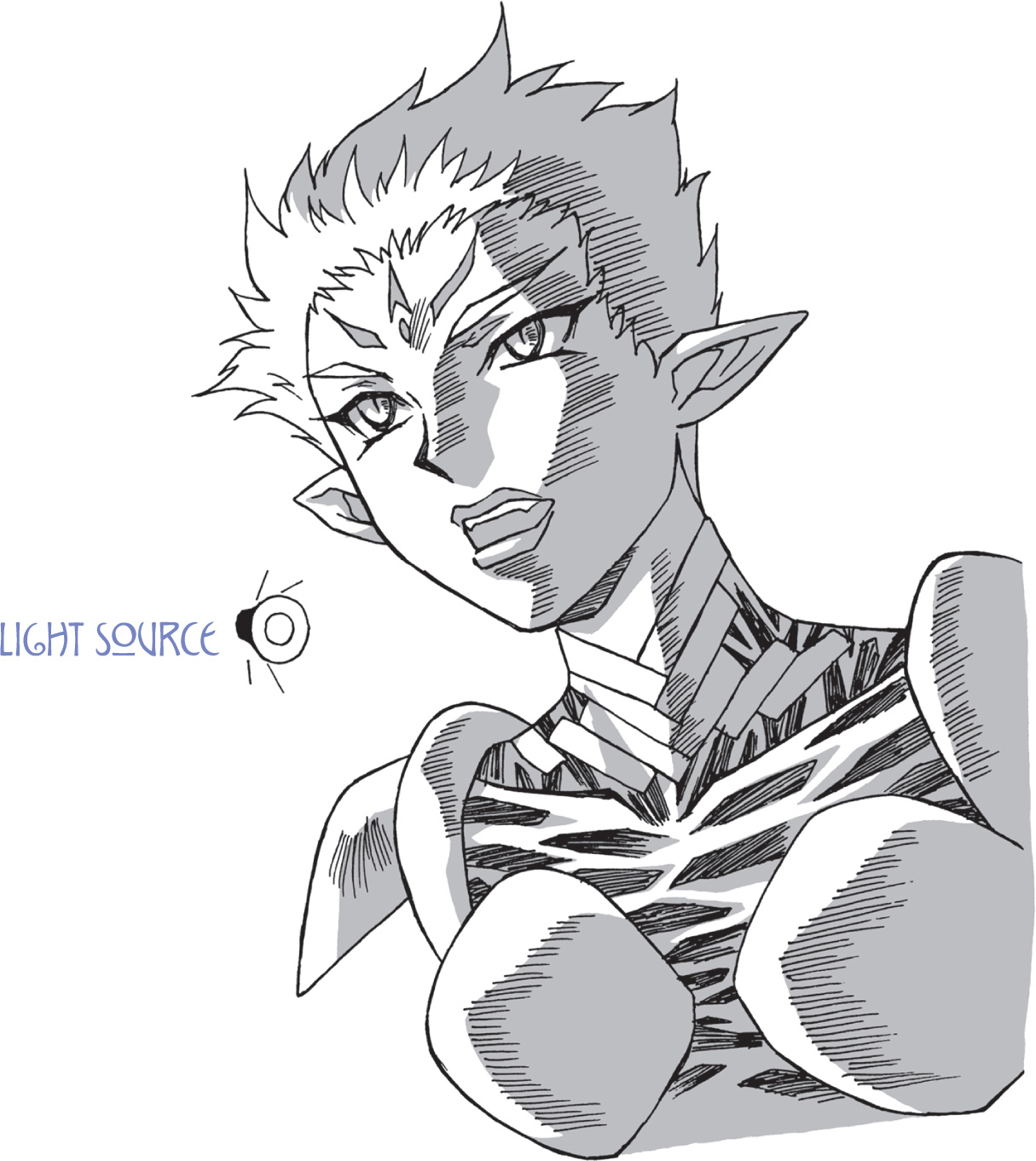
Shadows that fall on the ground under characters fix the figures in place so that they don’t appear to be floating on the page. Ground shadows also show the audience where the horizon is. In addition, they are another tool in the artist’s arsenal. For example, a jagged shadow underscores the violence of an action pose. A small shadow adds a poetic feeling to a lonely moment.

With the light source located at about two o’clock, the shadow is long. If the light source were even lower—for example, down at the character’s right fist—the shadow would grow longer still.

Use a forward-leaning shadow for an action figure.

With the light source almost at noon, high overhead, the shadow is at its smallest.
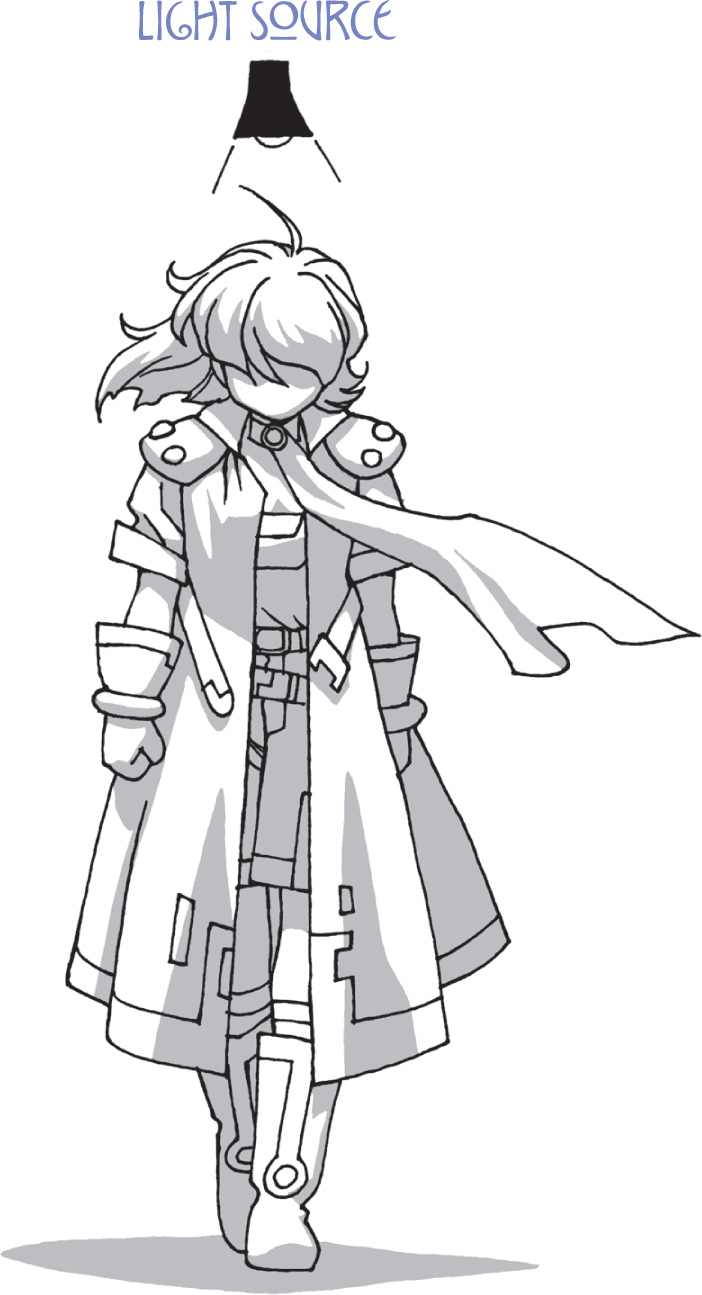
LONE WARRIOR
For her, a small shadow underfoot signifies her world: She is an island unto herself.
Shading can also be used to heighten the look of special effects, making the moment more brilliant. But remember to make the special effect burst of light really stand out—the rest of the character must be in shadow.
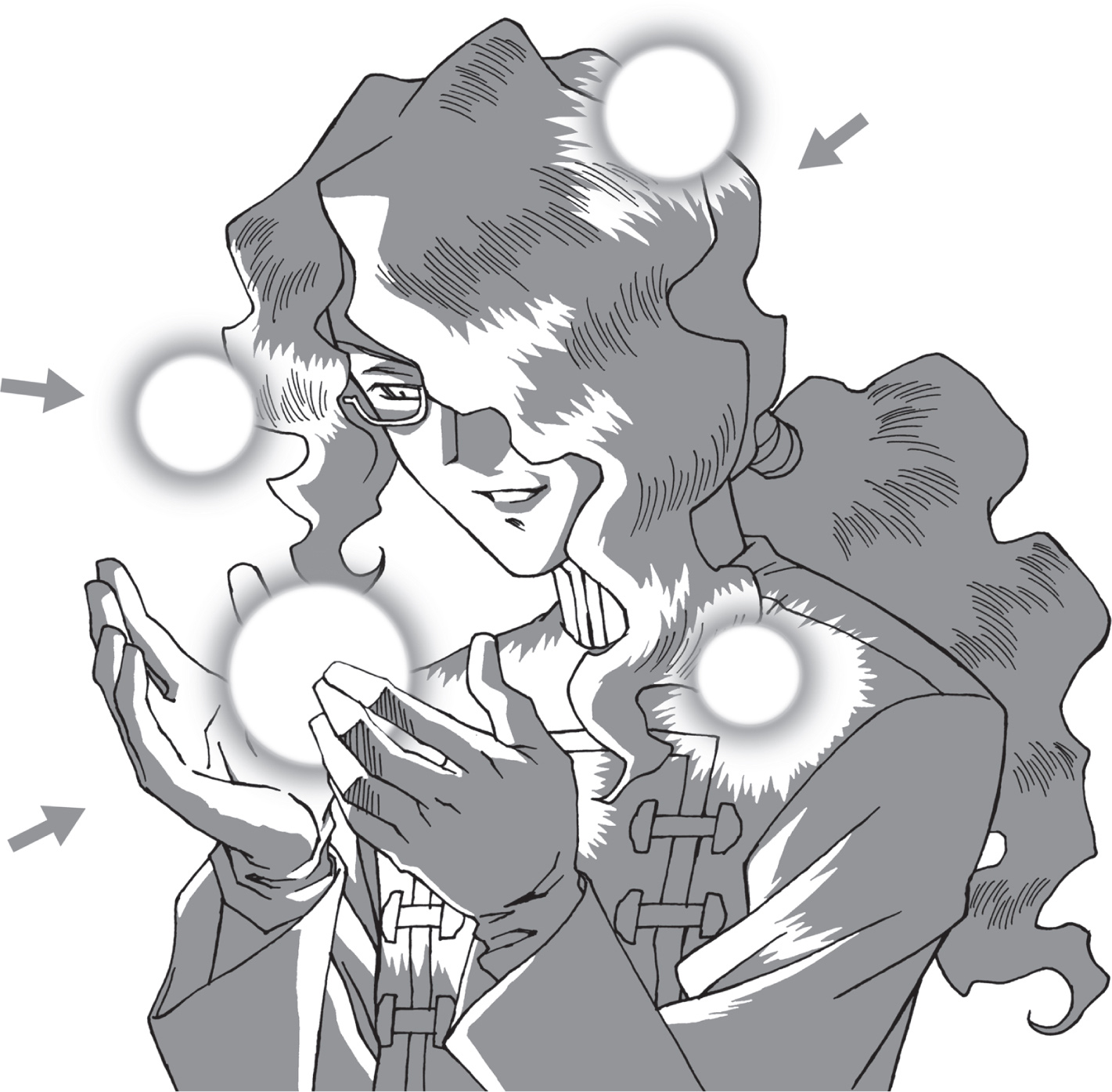
Magical effects have soft shading that makes them enchanting. In order for the spheres of light to look so luminous, the character (as well as the background, if there is any) needs to be dark. The magic sphere gives off light, as if radiating warmth.

The burst from gunfire is a sudden and intense flash. The flash itself is the light source. The blast of light cuts out a small, sharp template of light in the character, the edges of which are hard and severe. Everything else falls off immediately into shadow.
Mirrors and reflections hold a strange fascination. They are a common visual theme in manga occult stories about possession and other spooky stuff. There’s something weird and haunting about the world that lies on the other side of the mirror. Is it real or just a reflection? Can we step through to some other place where we will come face to face with a duplicate of ourselves? So, how do you incorporate mirrors and reflections? Take a look.
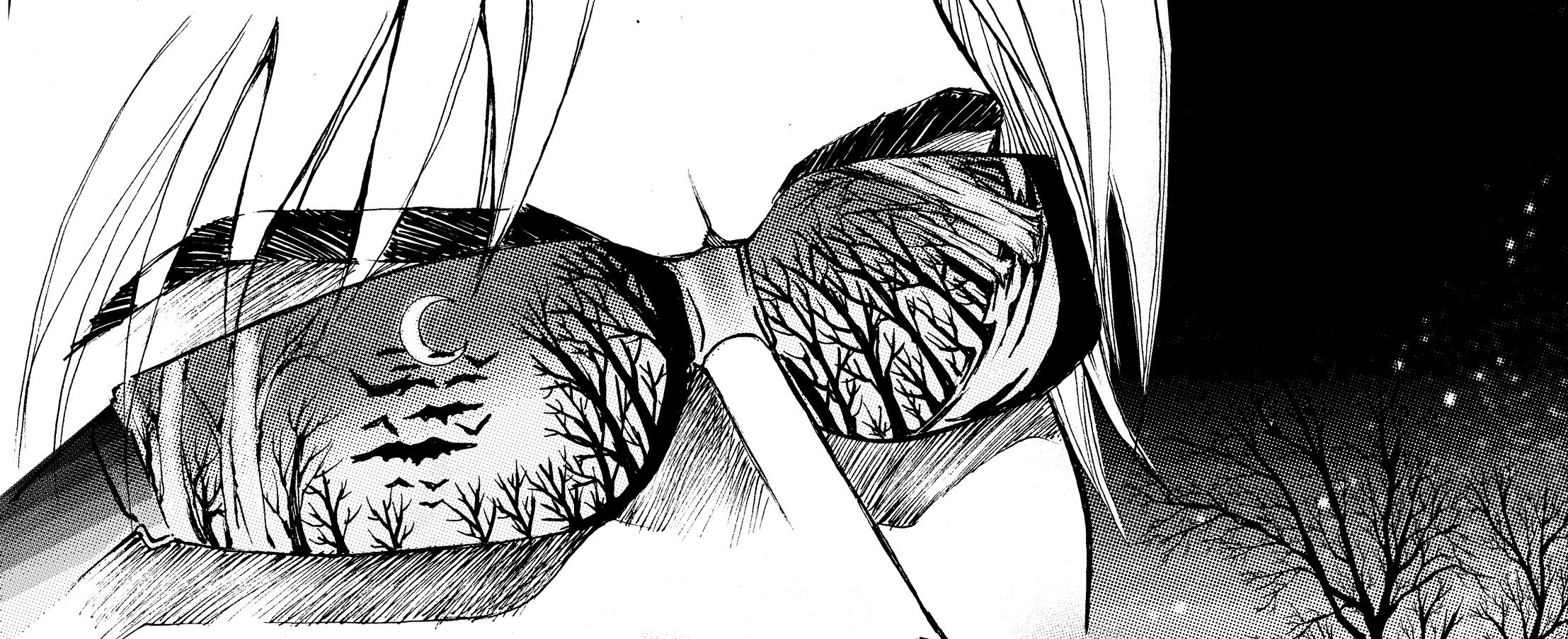
REFLECTION IN GLASSES
Instead of drawing a picture of bats flying on the horizon for example, try drawing the bats as a reflection in a character’s eyeglasses. Since the lenses are always slightly curved, this will warp the horizon distorting the picture plane in a bizarre way and resulting in a creepy look. Tree branches will bend together as they reach skyward, almost like fingertips. But here’s a point to remember: You can use reflections and mirrors as a substitute for ordinary shots to create extraordinary images.

REFLECTION IN WATER
The reflection speak back to its source. The you don’t know who the master is—the person or the reflection!

CAUGHT IN A MIRROR
Suddenly, the world starts spinning and your character finds herself caught in a mirror-nightmare world, with no way back!
REFLECTION IN THE EYE
In this particular type of shot, the reader sees what the eye is seeing, as reflected in the pupil. It’s a very dramatic angle and an extreme close-up.
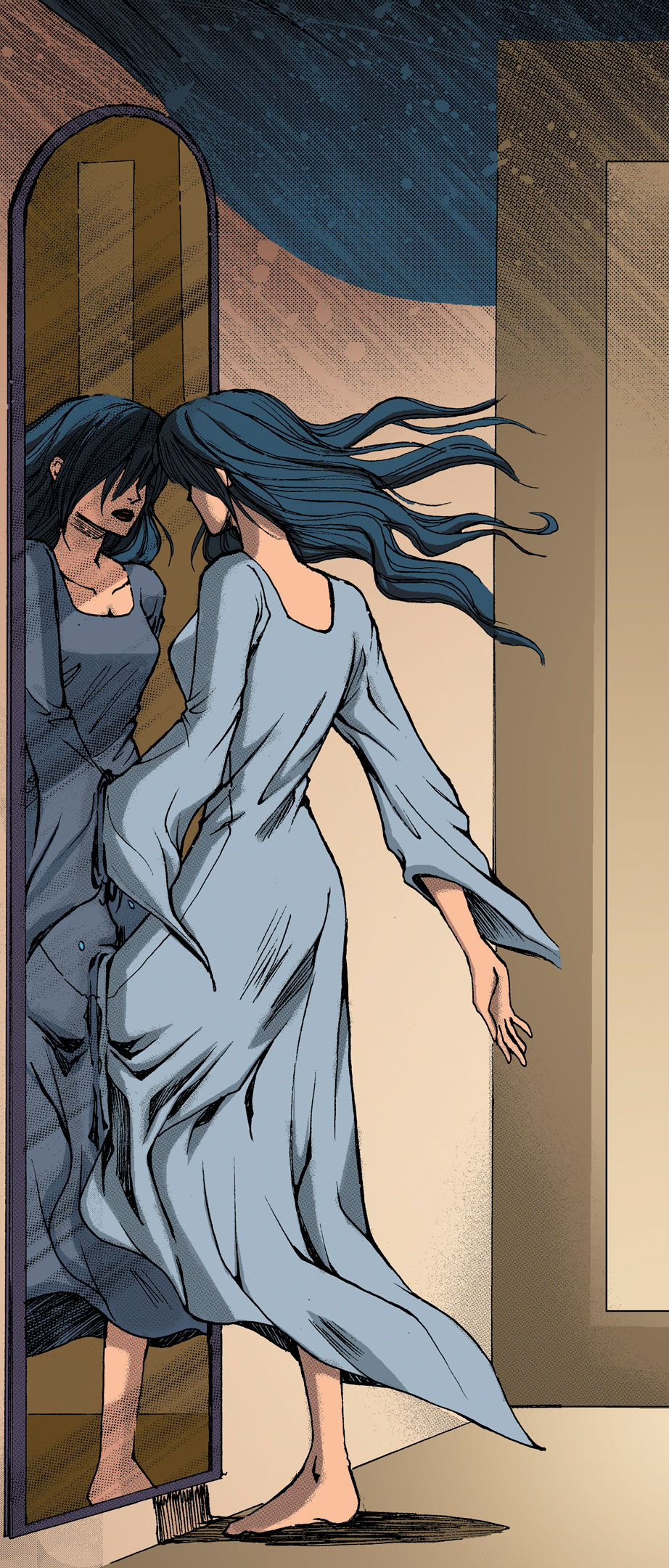
STEPPING THROUGH THE MIRROR
The figure must move slowly, gracefully, as if moving through water, with hair and gown flowing.

IN HANDHELD MIRRORS
The silver handheld mirror is a precious old-fashioned ornament, almost witchlike in nature.
The world of occult and horror is an exciting and fascinating genre because nothing is quite what it seems. Beasts are men. Women are vampires. Children are possessed. You’ve got to stay on your toes. It keeps the reader on edge, and that’s a great place to be—out of the comfort zone and glued to the next panel, the next sentence, the next illustration.
In occult and horror, regular scenes sometimes turn into dream sequences or even nightmares. These are very cool, visually entertaining panels that are like entering a haunted-house amusement park ride. For example, maybe you want the character to discover that the evil one has placed her in a nightmare from which she can’t wake up. That’s a visually dizzying effect.

CHILD’S BEDROOM: ORDINARY
Peaceful, serene, neat. Plenty of vertical and horizontal lines translate into a feeling of stability.

CHILD’S BEDROOM: DREAM SEQUENCE
The straight lines are gone; everything goes wiggly. Inanimate objects take on life and personality. The mirror becomes a portal through which “others” try to enter. Walls, too, become doorways to other worlds, as witnessed by the hands reaching through the walls and ceiling in the upper left corner. Objects and things (lamps, pillows, and so on) rock back and forth. Faces appear in objects (the work desk, trash can, and ceiling).
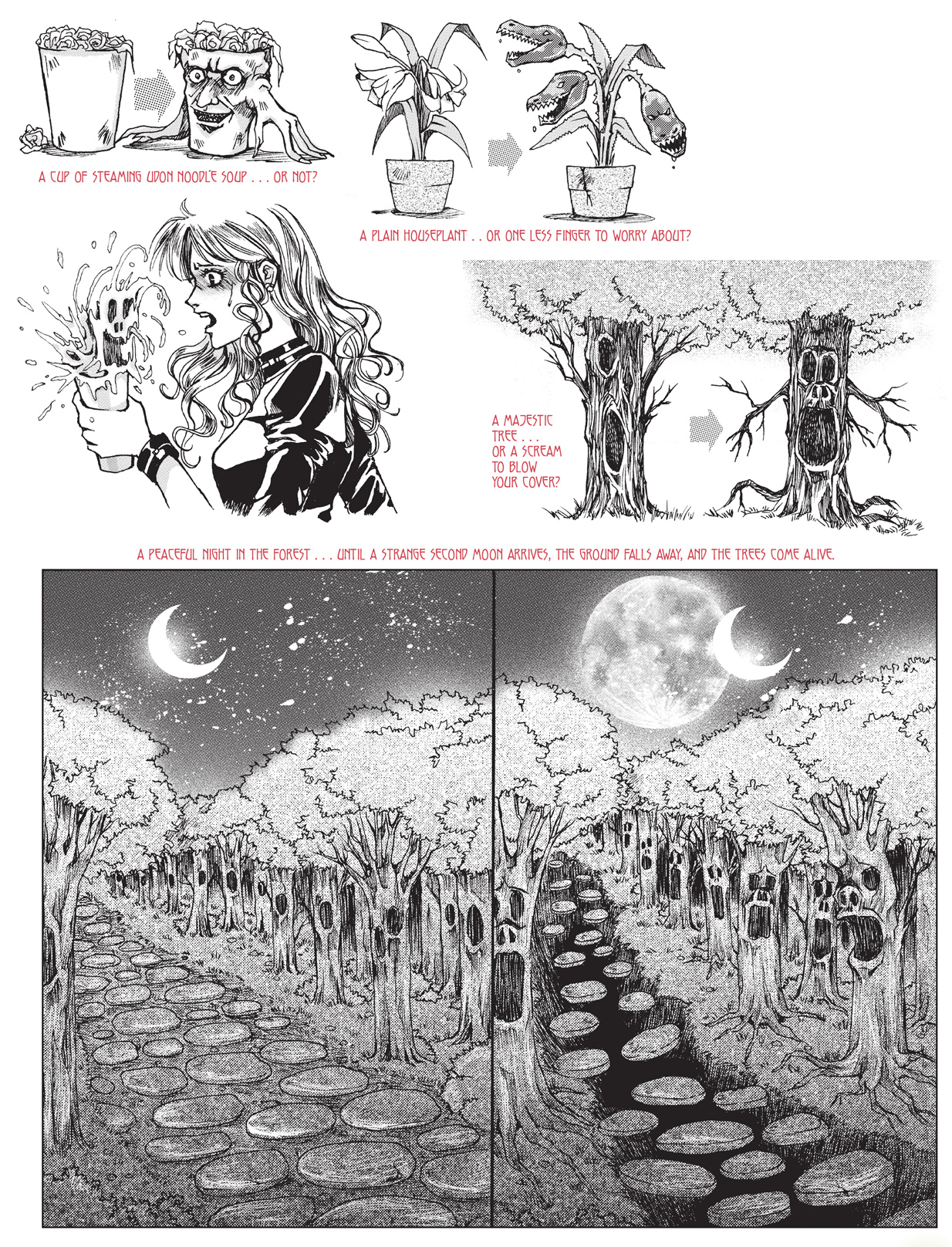
In the land of haunted dreams, inanimate objects morph into weird and scary things. In nightmares things are never what they seem. A word to the wise: Be careful if you find yourself awake and in a nightmare. And if you’ve got a good-luck charm in your pocket, for god’s sake, don’t drop it!
Symbols of the occult are a very important part of this genre. They decorate and embellish scenes and images and even the clothes. Occult symbols even intimidate non-occult characters. A list of symbols appears below, but you don’t have to use all of them simultaneously. You can use a combination of only a few. It all depends on the type of character you’re trying to create and how much he or she is trying to blend in as an ordinary human.

I want this book to grow with you, to take you from the basics of drawing faces and bodies to designing your own characters to, ultimately, placing characters in full scenes that you compose if you want to take it that far. So to that end, here are some suggestions of locations for occult-and-horror stories that remain extremely popular with readers from the U.S.A. to Japan and everywhere in between. These locations are designed more to inspire you than to give you a rigid template to copy. These are simply a few good choices to keep in mind when you want to set the mood for your scenes.

DESERTED FARMHOUSE
A broken-down car (no good for escape—it’s just a tease). Overgrown weeds. A small house. You can hide, but you can’t run … very far, that is. There’s nowhere to run to! And when night falls, it gets very, very dark. The enemy knows the lay of the land, but you don’t.

CASTLE BY THE SEA
A huge electrical storm. No boats. No horses. No way out. Just a cozy couple of nights at the inn with the Baron and his wife. Lucky you. Hope you packed a lot of Band-Aids. (And note the crushing whitecaps as they splash up against the rocks, making a dramatic display of the storm’s power.)

EMPTY PLAYGROUND IN THE RAIN
Bleak. Lonely. Someone is watching. The rain slashes down at an angle. Leaves scatter in the wind. Swings are pushed up and sideways. Wind is a bad omen in the occult genre, a harbinger of things to come.
CEMETERY
Wrought-iron gates. A lawn with tombstones of varying shapes and sizes. Silhouettes of leafless trees with twisted, knotty branches. These are all the prime ingredients for a cemetery. In addition, there’s always a full moon in a cemetery because a full moon casts a hard shadow, which results in a lot of rich blacks. Without a full moon, the light would be diffused and soft.

NIGHT IN THE CITY
Nice place for a little stroll. If you’re a zombie, that is. Draw the scene at a diagonal to give the scene an unsettled feeling. This is called a tilted frame look. It’s a good way of making your readers feel agitated as they go to the next scene. And that’s how they want to feel when reading an occult-and-horror book: on the edge. But you’ve got to provide the payoff in the following panel with something good. You cannot—I repeat, cannot—continue to build up the suspense without providing a payoff.
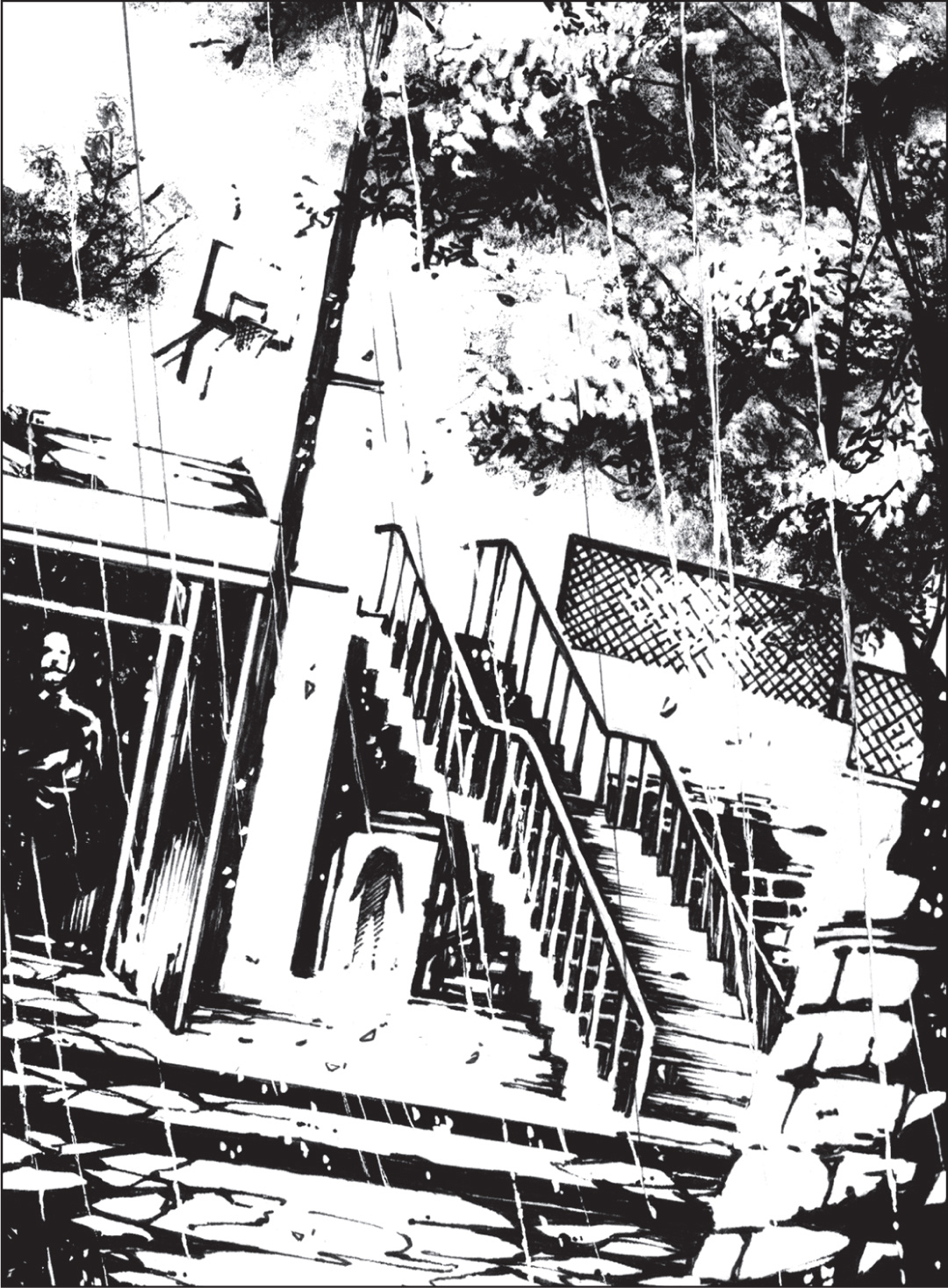
NIGHT IN THE PARK, ALONE
You’d think you’d be safer out in the open than holed up in a shack in the woods. But, you’d be wrong because behind each tree, under each staircase, walking across every meadow and baseball diamond are dozens of zombies—closing in from around the park’s perimeter.
So how, exactly does he do it? How does he charm and mesmerize his beautiful victims, and deliver the final Bite of Darkness? You can’t communicate this information to your reader if you don’t put the scenes in the proper storytelling sequence. All of the essential “beats” must be laid out, creating a sequential scene that moves like clockwork. The following pages will take you through a pivotal scene panel by panel, breaking down the pacing and plot development for you.

We come to the moment of truth, the moment we’ve all been waiting for: when all will be revealed. It is the annual ball at the Baron’s castle. Only the Who’s Who of high society are in attendance. They scene begins with them mingling. The host, the young Baron, is an introspective man, set apart from the others and unnaturally young for his years. He will honor his guests with his presence—while at the same time looking to reinvigorate his youth by unholy means. He’s hungry, distracted, on the prowl for new prey.
THE LOOK
The Baron catches the eye of a beautiful heiress. She is standing on the balcony, alone.

THE FLIRTATION
They talk, flirt. She finds him charming, but somehow, she feels uncomfortable around him. He invades her personal space.

THE TEMPTATION
She doesn’t trust herself around him. She leaves him and goes outside to the balcony.

THE PURSUIT AND SEDUCTION
He follows her. Brings her in tight. She finds herself weakening and dares not look at him. (I, too, have this effect on women.)
THE SPELL
He turns her around so that she looks deeply into his eyes. She’s caught fast in his spell.

THE KISS
They kiss passionately. (Here’s where they usually tell me they’re tired and have a lot of work to catch up on but had a really great time.)

THE SUBMISSION
She leans her head back, offering him her neck.

THE BITE
He reveals his eyeteeth— sharp vampire fangs.
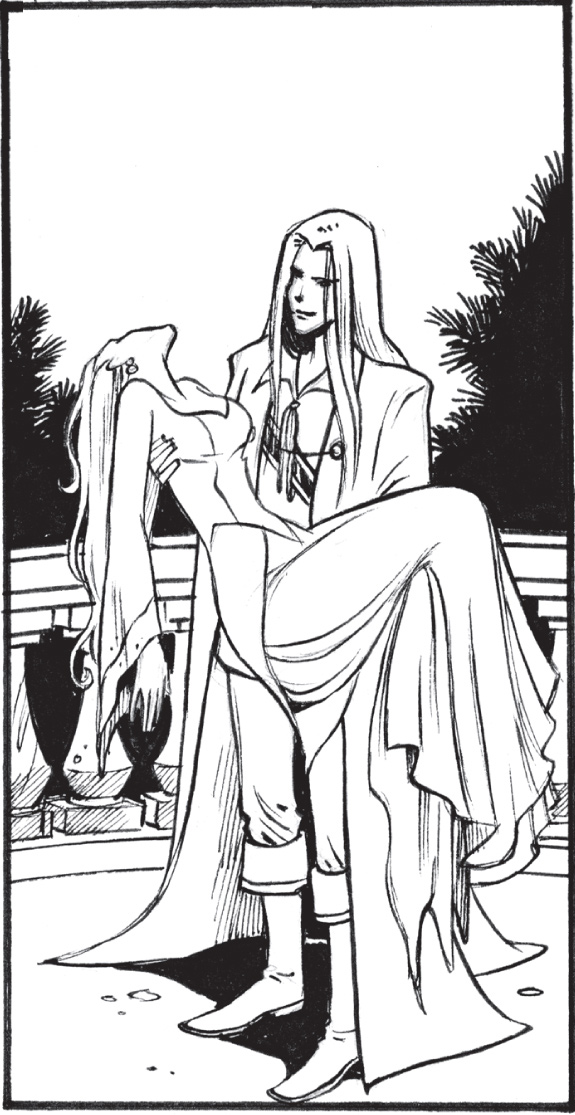
THE SLUMBER
And it is done. She falls asleep …

THE AWAKENING
… and awakens as a vampire to spend eternity as the undead.
The occult-and-horror genre is more than a style or a drawing; it’s also a mood. You cannot use the same palette that you would to color bright, happy shoujo-style manga. It would completely sabotage all that hard work you put in at the drawing board. Dark and mysterious are the adjectives that should inform your world of color choices here. And note that dark and mysterious are interesting and compelling color strategies. Just because they’re not bright doesn’t mean they’re not stimulating to the eye. Just keep these four important points in mind:
![]() Don’t go so dark that the lines and characters are hard to make out.
Don’t go so dark that the lines and characters are hard to make out.
![]() Every dark image needs bright areas in it or it will appear to fade away.
Every dark image needs bright areas in it or it will appear to fade away.
![]() Even a darker image should use a wide range of colors.
Even a darker image should use a wide range of colors.
![]() Dark doesn’t man dreary.
Dark doesn’t man dreary.

ORIGINAL PENCIL SKETCH

BLACK-AND-WHITE VERSION

SHOUJO COLORS

OCCULT COLORS
Both color images use lots of pink, but the occult color scheme also makes use of lots of black, which gives the girl a gothic quality. The shoujo panel is too cheery.
The wan skin color in the occult version shows us that she’s a creature of darkness. The sky behind her indicates that it’s night. Time to wake up! The shoujo colors are too warm and soft. This vampire looks much too healthy. Looks like she works out at the gym every day and drinks a glass of milk with each meal. Also, I can’t tell what time it is from looking out the archway behind her, and that’s a problem, but it’s solved in the version with occult colors.

ORIGINAL PENCIL SKETCH
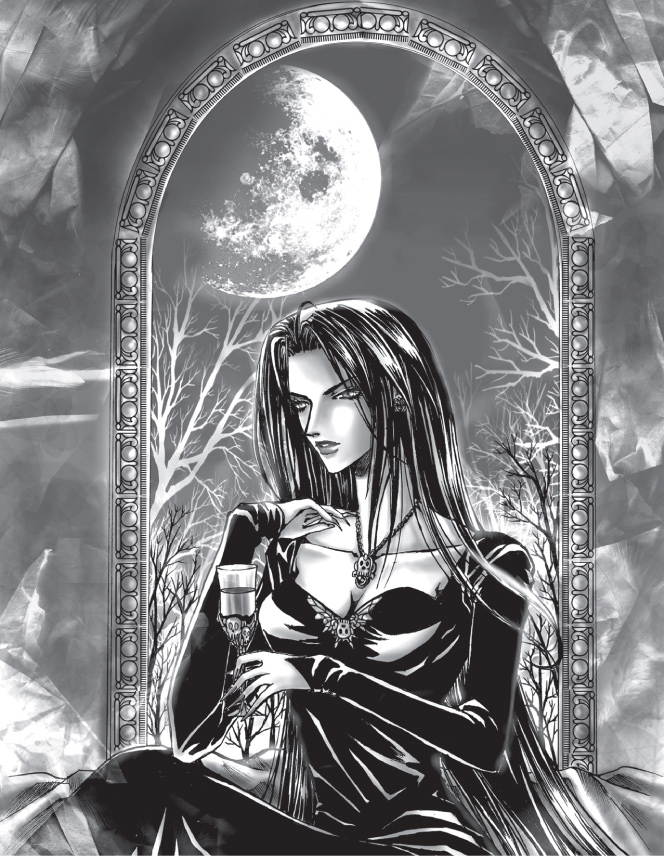
BLACK-AND-WHITE VERSION

SHOUJO COLORS

OCCULT COLORS
Yes, the fantasy colors are too bright; however, with his cape and sword, he’s almost straddling the fence between fantasy and occult, which are sometimes blended. So, this is pushing the envelope a bit, but not by that much.
In the occult version, darkness reigns with a warm, golden-reddish hue. Can’t argue with that. Feel the heat?
Bring up the red (a popular occult color), add a good amount of green (a popular fantasy color), and you’ve got a pleasing mixture of two genres in the fantasy/occult combo.

ORIGINAL PENCIL SKETCH

FANTASY COLORS

OCCULT COLORS
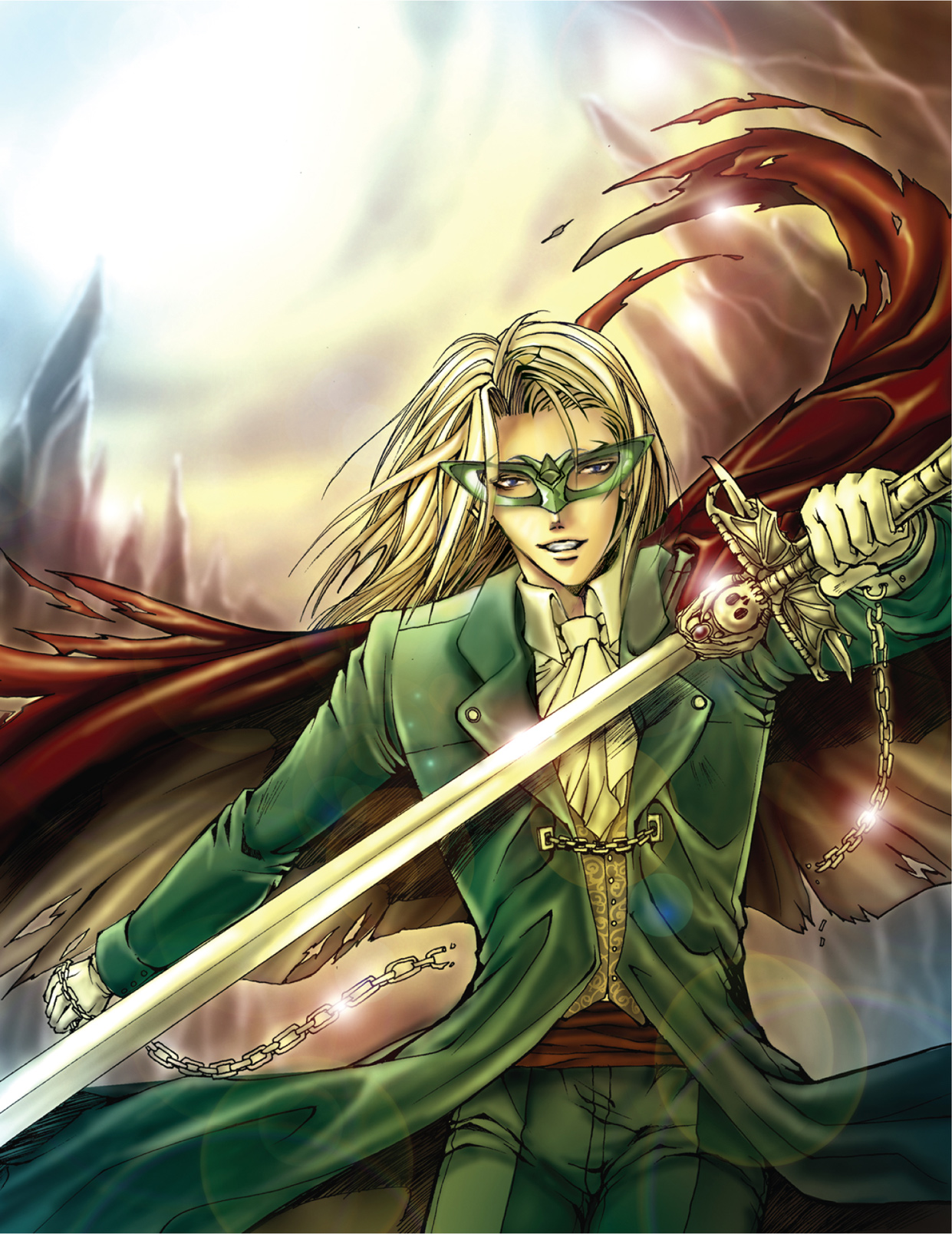
FANTASY/OCCULT COMBO